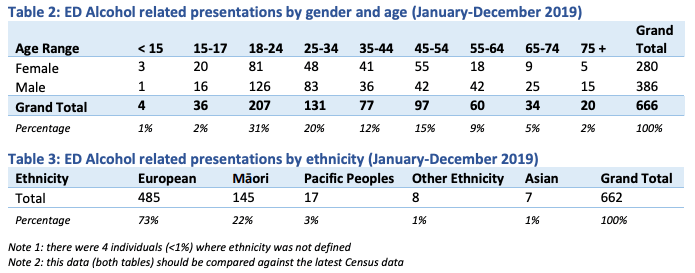
Reports released by Southern DHB have found almost 1 in 25 patient attendances to Southern DHB Emergency Departments are alcohol related.
Data from 24 months of electronic patient records of presentations at the hospital’s emergency departments in Dunedin, Southland and Lakes District Hospitals were examined and these were used to produce separate reports for 2018 and 2019 for each facility.
“Alcohol harm is one of the biggest preventable public health issues facing emergency departments and these reports can help to inform alcohol policy, and how and where we can work with our communities to reduce alcohol related harm,” says Southern DHB Medical Officer of Health, Dr Susan Jack.
The key findings of the reports are as follows:
- Almost 1 in 25 patient attendances at Southern DHB Emergency Departments are alcohol related
- Lakes District Hospital has the highest rate of alcohol related Emergency Department presentations (1 in 20 patients), followed by Dunedin Hospital (1 in 25 patients) and Southland Hospital (1 in 55 patients)
- The busiest times for alcohol related cases presenting to Southern DHB Emergency Departments in total were Saturday nights and Sunday mornings
- Males presented more frequently than females
- Dunedin had a higher percentage of 18 – 24 year olds presenting – 51% of all alcohol related presentations, compared to 36% at Lakes District Hospital and 33% at Southland Hospital (average of 2018 and 2019)
- For Dunedin, the warmer months were the busiest for alcohol related admissions (except for January), while the busy months for Lakes District and Southland range across the calendar.
Southern DHB Clinical Director of Dunedin Hospital Emergency Department, Dr Rich Stephenson says the reports clearly highlight the harm from excess alcohol consumption.

“The impact of alcohol on our health service is significant. Dealing with drunk and disorderly patients takes a lot of time and effort – this time could be used to treat patients whose illness or injury hasn’t been contributed to by the decision to consume alcohol to an extent likely to cause harm. Drunk patients can also be violent and pose a significant risk to our staff and other patients.”
The DHB aims to produce these reports every year. “We hope by informing policy and targeted projects we will begin to see a reduction in alcohol related harm,’ says Dr Jack.
Note: The reports are only a snapshot of alcohol related harm. They use data that reflects only acute harm and does not include presentations to other parts of the health system or the full range of harms from alcohol and their costs to both individuals and the community.
